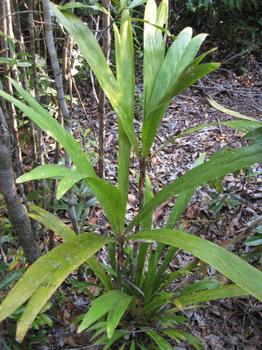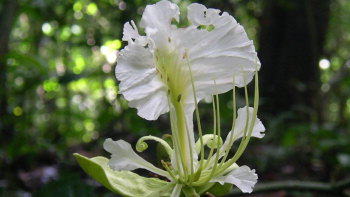One-fifth of All Plant Species at Risk of Extinction
LONDON, UK, September 29, 2010 (ENS) – One in every five of the world’s plant species is threatened with extinction, biodiversity experts said today in the first global analysis of extinction risk for the world’s estimated 380,000 plant species.
Conducted by scientists at the Royal Botanic Gardens, Kew together with colleagues with the Natural History Museum, London and the International Union for the Conservation of Nature, IUCN, the assessment presents a baseline for future plant conservation.
Most of the threatened species are found in the tropics, the report shows. The greatest threat is habitat loss caused by human activities, mostly the conversion of natural habitats for agriculture or livestock use.
The analysis was released today as governments prepare to meet in Nagoya, Japan in mid-October to set new conservation targets at the United Nations Biodiversity Summit.
“This report comes at an important time in the lead up to the major international biodiversity meeting in Nagoya next month,” said UK Environment Secretary Caroline Spelman. “It is deeply troubling that a fifth of the world’s plants are facing extinction because of human activity. Plant life is vital to our very existence providing us with food, water, medicines, and the ability to mitigate and adapt to climate change.”
“We must take steps now to avoid losing some of these important species and the UK will show leadership as we look to make progress towards a framework for tackling the loss of the Earth’s plant and animal species,” she said.
 |
Botanist Linda Loffler with the critically endangered yam species, Dioscorea strydomiana, from South Africa. Considered a cancer cure, the 200 known plants are targeted by medicinal plant collectors who cut pieces off the tubers. (Photo by John Burrows courtesy Royal Gardens, Kew) |
For the first time we have a clear global picture of extinction risk to the world’s known plants,” said Professor Stephen Hopper, director of the Royal Botanic Gardens, Kew.
“This report shows the most urgent threats and the most threatened regions. This study confirms what we already suspected, that plants are under threat and the main cause is human-induced habitat loss,” Hopper said.
Scientists from the Kew, the Natural History Museum and the IUCN Specialist Groups assessed a representative sample of the world’s plants, in response to the United Nations’ International Year of Biodiversity and the 2010 Biodiversity Target.
The 2010 Biodiversity Target was set in April 2002, when the governments that are Parties to the Convention on Biological Diversity committed themselves to achieve by 2010 a significant reduction of the current rate of biodiversity loss at the global, regional and national levels as a contribution to poverty alleviation and to the benefit of all life on Earth.
This target was endorsed by the World Summit on Sustainable Development and the United Nations General Assembly and was incorporated as a new target under the Millennium Development Goals.
But in April, a report on over 30 indicators concluded that world leaders have failed to reduce the global rate of biodiversity loss by 2010 and have instead overseen biodiversity declines.
 |
This dwarf palm from Madagascar, Dypsis brevicaulis, is threatened by forest destruction. Fewer than 50 plants have been found in the wild. (Photo by John Dransfield courtesy Royal Gardens, Kew) |
That study’s lead author, Dr. Stuart Butchart of the UN World Conservation Monitoring Centre and BirdLife International, said, “Our data show that 2010 will not be the year that biodiversity loss was halted, but it needs to be the year in which we start taking the issue seriously and substantially increase our efforts to take care of what is left of our planet.”
Next month the meeting in Nagoya will attempt to set a 2020 biodiversity target that will likely be to halt biodiversity loss and the degradation of ecosystems services by 2020, and to restore them wherever feasible.
“The 2020 biodiversity target that will be discussed in Nagoya is ambitious, but in a time of increasing loss of biodiversity it is entirely appropriate to scale up our efforts,” said Hopper. “Plants are the foundation of biodiversity and their significance in uncertain climatic, economic and political times has been overlooked for far too long.”
The assessment released today shows that plants are more threatened than birds and as threatened as mammals, but plant species are less threatened than amphibians or corals.
Both common and rare species were assessed in order to give an accurate picture of how plants are faring around the world.
The most threatened habitat is tropical rainforest. The study points out that the current rate of loss of tropical forest accounts for 20 percent of global carbon emissions.
Gymnosperms are the most endangered plant group. These seed-bearing plants whose seeds do not form inside fruits but outside, include conifers, cycads, ginkgo and the tropical evergreen trees, shrubs and lianas called gnetales. Many of these gnetum species are edible, as the seeds are roasted, and the foliage is used as a vegetable. Some are valued as herbal medicine.
In a separate study published in July, a trio of American and British researchers warned that thousands of rare flowering plant species worldwide may become extinct before scientists can even discover them.
“Scientists have estimated that, overall, there could be between 5 million and 50 million species, but fewer than two million of these species have been discovered to date,” said lead author Lucas Joppa of Microsoft Research in Cambridge, UK. “Using novel methods, we were able to refine the estimate of total species for flowering plants, and calculate how many of those remain undiscovered.”
Based on data from the online World Checklist of Selected Plant Families at the Royal Botanic Gardens, Kew, the scientists calculated that there are between 10 and 20 percent more undiscovered flowering plant species than previously estimated. The study was published in the journal “Proceedings of the Royal Society B.”
Joppa said, “This finding has enormous conservation implications, as any as-yet-unknown species are likely to be overwhelmingly rare and threatened.”
 |
Flower of Berlinia korupensis (Photo courtesy RBG Kew) |
Scientists are continually discovering plant species previously unknown to science. Among the more than 250 new species discovered or described by Kew scientists in the past year are massive flowering trees in the rainforests of Cameroon.
The tallest is the Berlinia korupensis, named by Dr. Barbara Mackinder, which stands 42 meters in height. A member of the pea family, the Berlinia bears beautiful white flowers with enormous pods that explode when ripe, propelling the seeds away from the mother tree.
Surveys of the Cameroon’s Korup National Park show that this tree is extremely rare. “We found just 17 trees in our surveys,” said Kew’s Xander van der Burgt. “Even though Korup is protected, Berlinia korupensis is critically endangered due to human pressures on the park.”
The assessment released today adds to the Sampled Red List Index for Plants, which analyzes a large sample of plant species that collectively represent of all the world’s plants.
The Sampled Red List Index for Plants is part of the IUCN’s authoritative Red List of Threatened Species, a worldwide effort to create a tool to monitor the changing status of the world’s major groups of plants, fungi and animals.
“We cannot sit back and watch plant species disappear – plants are the basis of all life on Earth, providing clean air, water, food and fuel,” Hopper said. “All animal and bird life depends on them and so do we. Having the tools and knowledge to turn around loss of biodiversity is now more important than ever and the Sampled Red List Index for Plants gives conservationists and scientists one such tool.”
Copyright Environment News Service (ENS) 2010. All rights reserved.
